If you want to get your employees informed and engaged, your internal communications need to catch their attention. By following internal email best practices, you can accomplish this goal and see a boost in employee engagement across the board.
Picture this: you send out your email newsletter to the entire organization. Yet days go by without anyone saying anything about it. You send a reminder email about things you mentioned in the internal newsletter. In response, you get a bunch of questions like: “What? I didn’t know we could get the flu shot at the office!” “Is office yoga still happening?” “When are we being sent our tax information?”
It’s not your fault, but it’s not your employees’ fault either. People dread more clutter in their email inboxes. By adhering to internal email best practices, and choosing the right internal communications tools, you can tackle the dilemma of low readership head-on.
Building an Employee Email Strategy
Despite the rise of other communication tools like chat platforms and intranets, email remains one of the most popular channels for internal communication in the workplace. It provides a centralized location for employees to receive important updates and information, and allows for more detailed and structured messages than other forms of communication.
However, with so many emails flooding employees’ inboxes every day, it’s important to have a clear and effective employee email strategy in place. Without one, important messages can get lost in the shuffle, leading to confusion and disengagement among employees.
Here are some specific reasons why building an employee email strategy is so important:
- Ensures consistency: By establishing a regular cadence for internal emails, you can ensure that employees are receiving consistent messaging and staying up-to-date on company news and initiatives.
- Improves engagement: Well-crafted emails that are concise, engaging, and relevant can increase readership and engagement among employees. This, in turn, can lead to better alignment and understanding of company goals and values.
- Increases transparency: Email can be a valuable tool for promoting transparency within an organization. By sharing company news, updates, and achievements via email, you can help build trust and openness among employees.
- Provides a record of communication: Finally, email provides a record of communication that can be referenced later on. This can be especially helpful for sharing important information or decisions with new employees or those who may have missed a previous message.
By taking the time to craft targeted, engaging emails, you can foster a more informed and connected workforce, ultimately leading to increased productivity and success for your organization.
Take your email strategy to the next level by creating targeted email campaigns to different segments of your workforce. Using ContactMonkey’s list management feature, you can easily create custom email lists—without needing IT—so your employees only receive internal emails relevant to them.
Custom email lists created using ContactMonkey integrate with your Human Resource Information System (HRIS) like Workday and ADP, as well as Azure Active Directory. This means they’ll update automatically as employee join and leave your organization.
How to Create Engaging Employee Emails: 12 Internal Email Best Practices
These are our 12 internal email best practices for boosting engagement great employee newsletter ideas. Even if you just try one, we’re certain that you’ll end up creating more engaging internal corporate newsletters and emails.
1. Start with eye-catching subject lines
You might have the most beautiful, well-written employee newsletter on the face of the earth. But if there’s no incentive for employees to open it—like a sweet subject line—your email might as well be empty. That’s why creating an eye-catching subject line is one of the top internal email best practices.
Use short subject lines
Research from Retention Science has found that subject lines between 6-10 words have the highest open rates. Therefore, 8 words are ideal.
As well, most people check their emails on mobile devices. It can’t hurt to have a shorter subject line so that it displays fully and correctly on an interface like that.
Lead with desire
Put yourself in the shoes of your fellow employees. In order for them to open an email, your internal newsletter subject lines need to go beyond information to address their desires and needs.
For example, if your weekly pizza lunch is going to be replaced with something else, you have to find a way to catch their attention. Otherwise, they may just ignore the email and wait to see what happens when the provided lunch day rolls around. Consider the following internal email subject lines examples:
“Information about weekly pizza lunch” or “We’ve got a delicious surprise for lunch [emoji]”
Ask yourself: Which of these two emails would I open?
Make it personal
No one likes receiving an email that has obviously been sent to thousands of other people. By featuring your employee’s name in the subject line, your email will appear to be personalized for every recipient on your distribution list. With ContactMonkey, you can even integrate your HRIS to build out employee lists for a more catered experience. Don’t use distribution lists? See how to create a distribution list in Outlook in seconds.
With ContactMonkey’s Merge Fields feature, you can create a personalized subject line for every employee on your contact list. You can insert anywhere in your email—subject line or body text—your recipients’ real name or their display name.
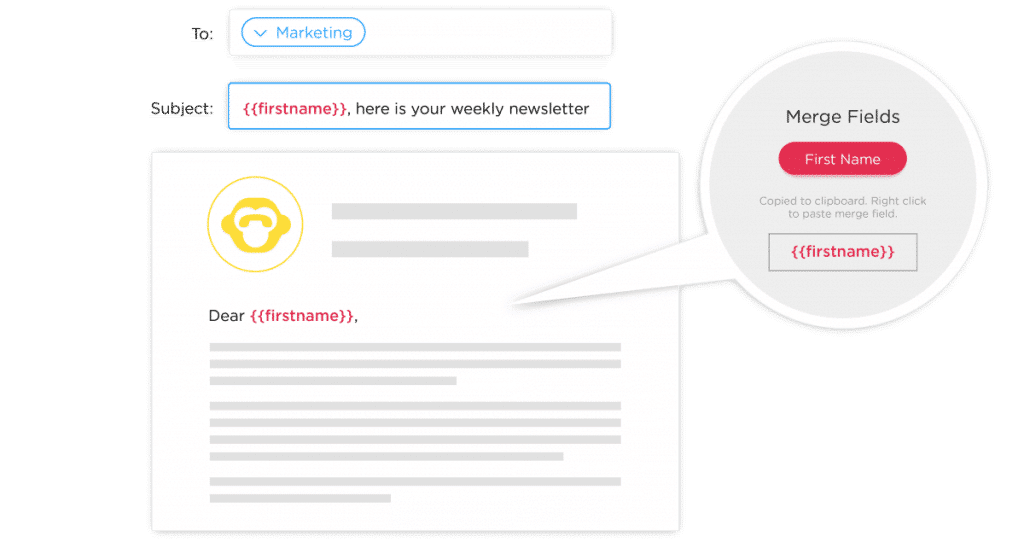
Good content keeps readers’ attention until the very end, so be sure to apply these tips throughout your newsletter. Keep your sentences short, use fun graphics and emojis to break up the text, and personalize your employee emails with custom text.
Want to learn more about personalized emails? Book a free demo to see how easy it is with ContactMonkey.
2. Design top-notch internal emails
You need not be a graphic designer to create a newsletter your employees enjoy reading. With email template building tools, like ContactMonkey, you can create professional-quality internal emails while saving time in the design process.
You’ll also be able to cross off another crucial internal email newsletter best practice off your list.
Here’s how to write an internal email that stands out, using a few handy ContactMonkey features:
Layouts
The layout of your internal newsletter is the foundation for your content. Even if the information in your email is valuable to your employees, a jumbled or cluttered layout will turn them off from reading.
Using ContactMonkey’s drag-and-drop template builder, you can easily customize the layout of your newsletter. Format your content using rows, dividers, buttons, pictures, videos, and more for endless design possibilities.
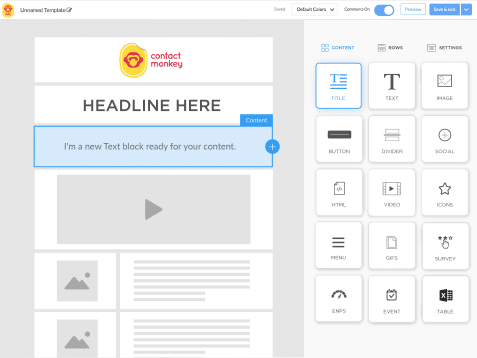
Using ContactMonkey’s click maps feature, you can see exactly how your employees are engaging with your emails. This data can help you optimize your email design to ensure important information gets seen by your employees.
Email Collaboration
With ContactMonkey, your internal communications team can work on your email templates simultaneously.
The initials of team members working on the dock will appear at the bottom of the email template builder, and you can see changes in real-time:
You can also leave comments for your team members and they’ll be automatically notified via email—just like in Google Docs.
3. Make the employee newsletter content relatable
Write engaging internal emails as if you’d want to read them. Look at it as a note to a friend. Be a real, approachable person. Especially when the news is serious, you’ll want to inject humanity.
Add visuals—like memes and GIFs—to break up email body
Memes have permeated every corner of social media. You can’t even scroll LinkedIn—which is supposed to be a strictly professional network—without coming across one (or five) memes or GIFs about sales.
ContactMonkey’s template builder has built-in Giphy integration. Simply drag the Giphy content block onto your template and then search Giphy’s library of hundreds of thousands of GIF images. With ContactMonkey, it’s super easy to add GIFs to your Outlook emails!
4. Link to relevant, shareable content
Since most people don’t finish reading emails (and sometimes don’t even open them), employees will undoubtedly miss some information.
That said, it can’t hurt to reuse some content in employee newsletters, especially when you’ve been getting a better feel for what they’re hoping to see.
Content worth sharing multiple times includes:
- Company initiatives and announcements
- Written content (blog posts, case studies)
- Press coverage
- Media (videos, podcasts, infographics)
- Industry news
One of our customers, University of North Texas, uses ContactMonkey to better understand whether employees pay more attention to announcements sent via email versus in-house displays.
5. Encourage employee feedback and two-way internal communications
Struggling to understand what employees actually want to read?
Including an employee feedback system in your internal newsletter—like emoji reactions, employee comments, or pulse surveys—can be a great way to start improving internal communications.
Emoji reactions
One of the most fun internal email best practices is to give your employees the ability to love, like, and laugh at any content you send them via email. With emoji reactions, your internal communications team can collect employee feedback seamlessly.
Employee feedback comments
The ways that internal communicators choose to engage with their employees should be reminiscent of technological experiences that they already enjoy. Basically, they should be:
- Interactive
- Social
- Visually appealing
- Mobile-friendly
Your employees are used to commenting on the content they interact with; give them that ability by with employee newsletter comments. By turning comments on in, ContactMonkey gives your employees a platform to voice their feedback:
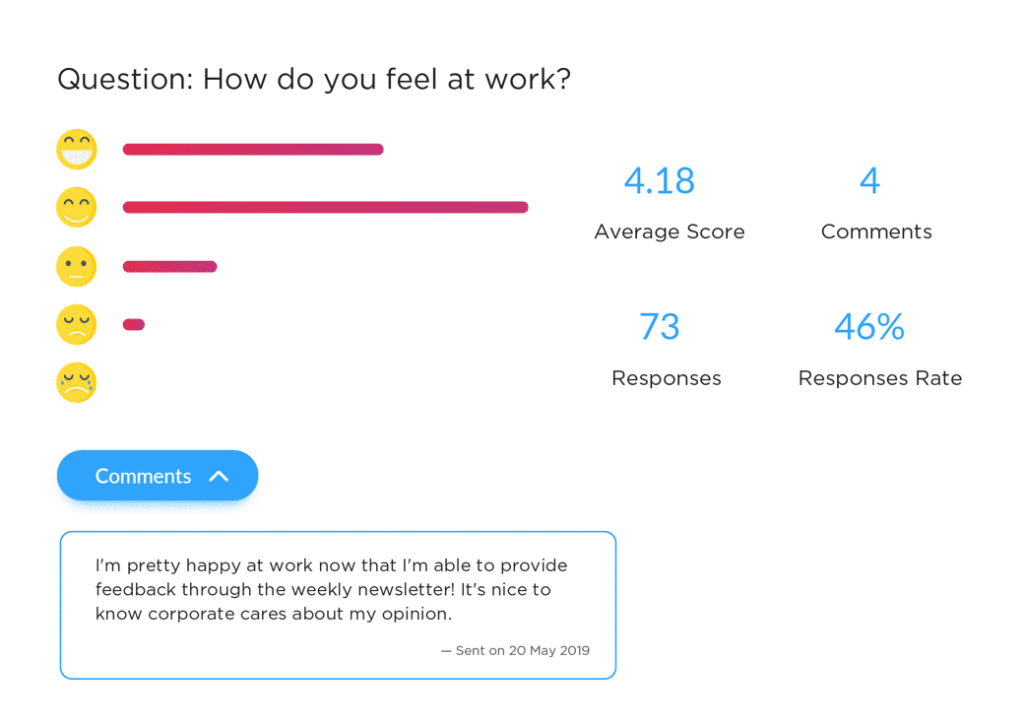
Combining comments with your emoji reactions is a win-win situation: your employees can look forward to giving their opinions on issues that matter to them, and you get to collect both qualitative and quantitative feedback from your internal newsletter. Not bad.
Employee pulse surveys
Employee pulse surveys are an effective way to combine emoji reactions and employee comments. With ContactMonkey’s pulse survey tools, you can gather actionable data on your email communications in seconds.
For instance, you might want to know how employees felt about the recent Town Hall meeting.
You could ask them “How did you find this month’s Town Hall?”.
Your employees can respond using emoji reactions, and add a comment if they’d like to add their two cents. The responses you receive will inform you of the success of the town hall, and might even give you specific points for improvement.
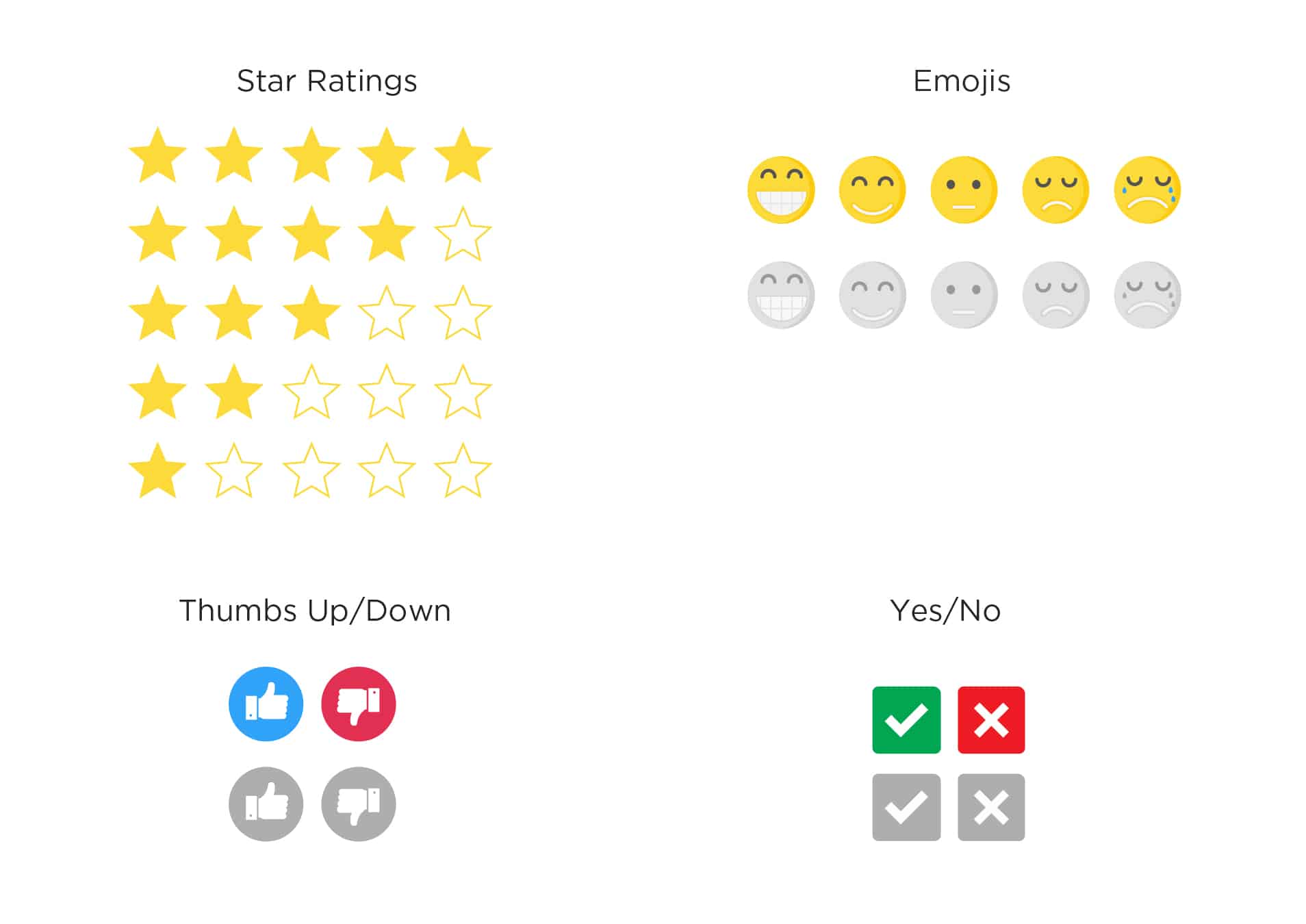
eNPS
Employee Net Promoter Score—or eNPS—is a system that allows you to determine which employees are most likely to recommend your product or your business as a place to work to their friends, family, or colleagues.
Measuring eNPS not only helps you know how engaged your overall workforce is, but it can help you find employees that could serve well as spokespeople—internal or external. Employees who are passionate about their work can help build morale and increase engagement in others.
ContactMonkey’s email template builder has a built-in eNPS feature that makes it easy to quickly gauge your employees’ engagement.
Simply ask a question that could be answered on a scale of 0-10 like “How likely are you to recommend our new product to friends or family?” on your email newsletter, and use the eNPS tile:
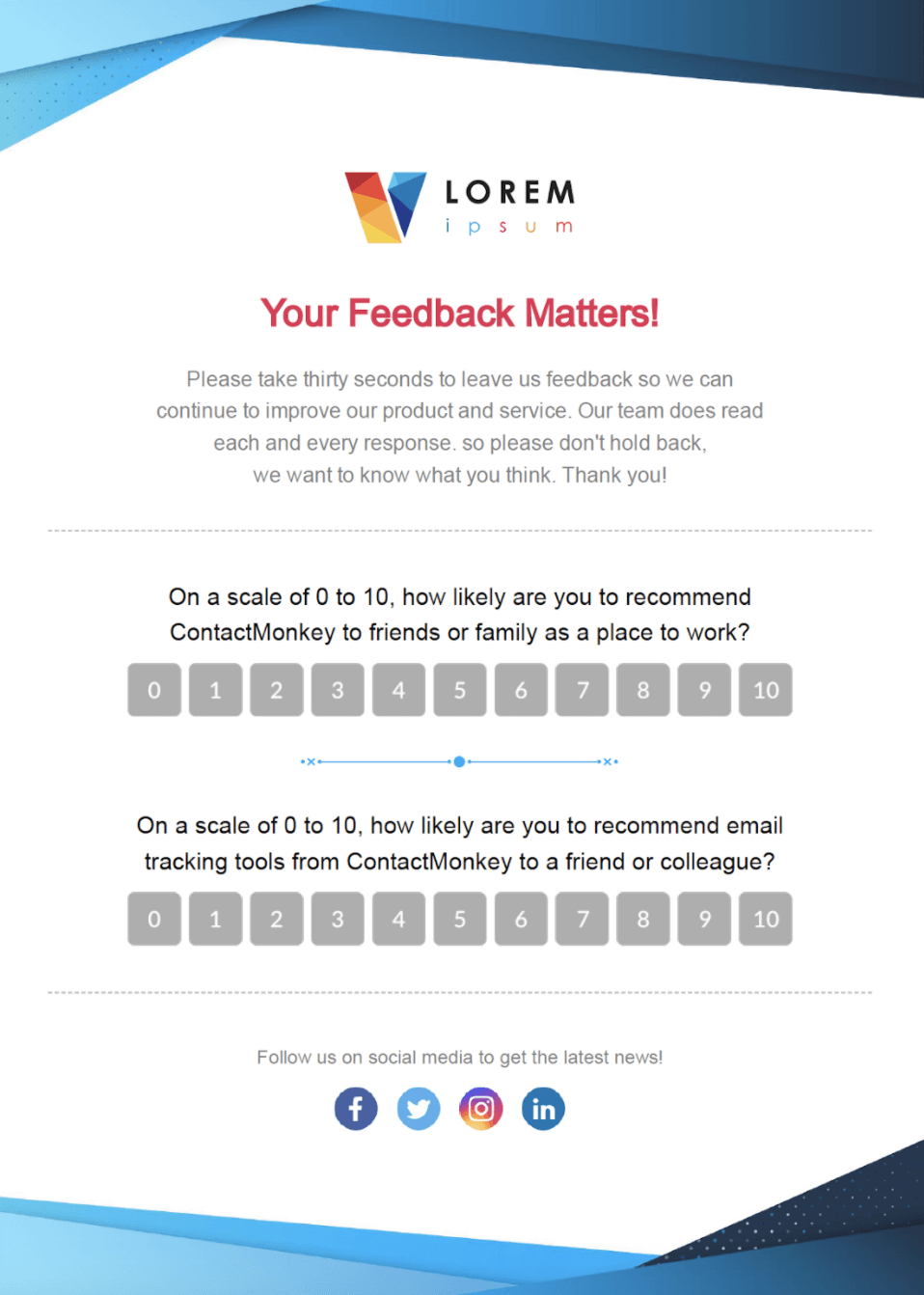
In addition to responding on a scale of 0-10, your employees can also leave anonymous comments where they can share their thoughts or ideas. eNPS is truly a win-win for businesses: you get to find how engaged your workforce is, and your employees feel heard by giving their input.
6. Optimize your internal email content
This is one of the most important yet most frequently overlooked internal email best practices.
Now that you’ve got your newsletter content together, it’s time to send it out and see how it’s received. Don’t get disappointed if you don’t strike newsletter gold with your first try; crafting an engaging internal email takes refinement!
Use generative AI
You can also utilize generative AI technology to help optimize your messages. ContactMonkey’s integration with OpenAI ChatGPT can help you save time while finding the right message. By incorporating generative AI into your internal communication strategy, you can:
- Save time: Rather than manually analyzing data, generative AI can quickly and efficiently propose content that might work for your audience.
- Increase engagement: By optimizing your email content with generative AI, you can create messages that are more engaging and effective at driving action from your team.
- Improve consistency: Generative AI can help you maintain a consistent voice and tone throughout your emails, ensuring that your message is clear and on-brand.
Text links vs. buttons
From a user experience perspective, text links are used more than buttons. Why? Because buttons register as images and take time to make, while links in text-only require the URL.
If the goal is to have employees interact with the company website, then use text links to lead them. If you’d rather them stay within the internal newsletter, then opt for buttons.
Employee newsletter length
Lengthier employee newsletters are perceived to convey more information. However, if you’re losing your audience shortly after they start reading, they’re going to miss a lot.
Statistically, 200 words (which equates to about 20 lines of text) have the highest click-through rates in the majority of industries. Overall, the best length for your employee newsletter depends on what your end goal is a.k.a. what action you’re hoping for employees to take.
Alternatively, if there is a lot of information to include, don’t be afraid to move away from text only. Instead, think about delivering the message via video internal communications or an infographic.
7. Track your internal emails
How will you know if any of these best practices made a positive impact on your internal communications? You could collect employee feedback and survey your employees to see what they think. But to demonstrate the substantive improvements to your internal communications, you need to start tracking your internal email metrics.
Open rate, click-through rate, read time, opens by device and location, and other statistics can show the real benefits of your internal communications. Using ContactMonkey’s email tracking software, you analyze the success of your internal emails from your analytics dashboard:
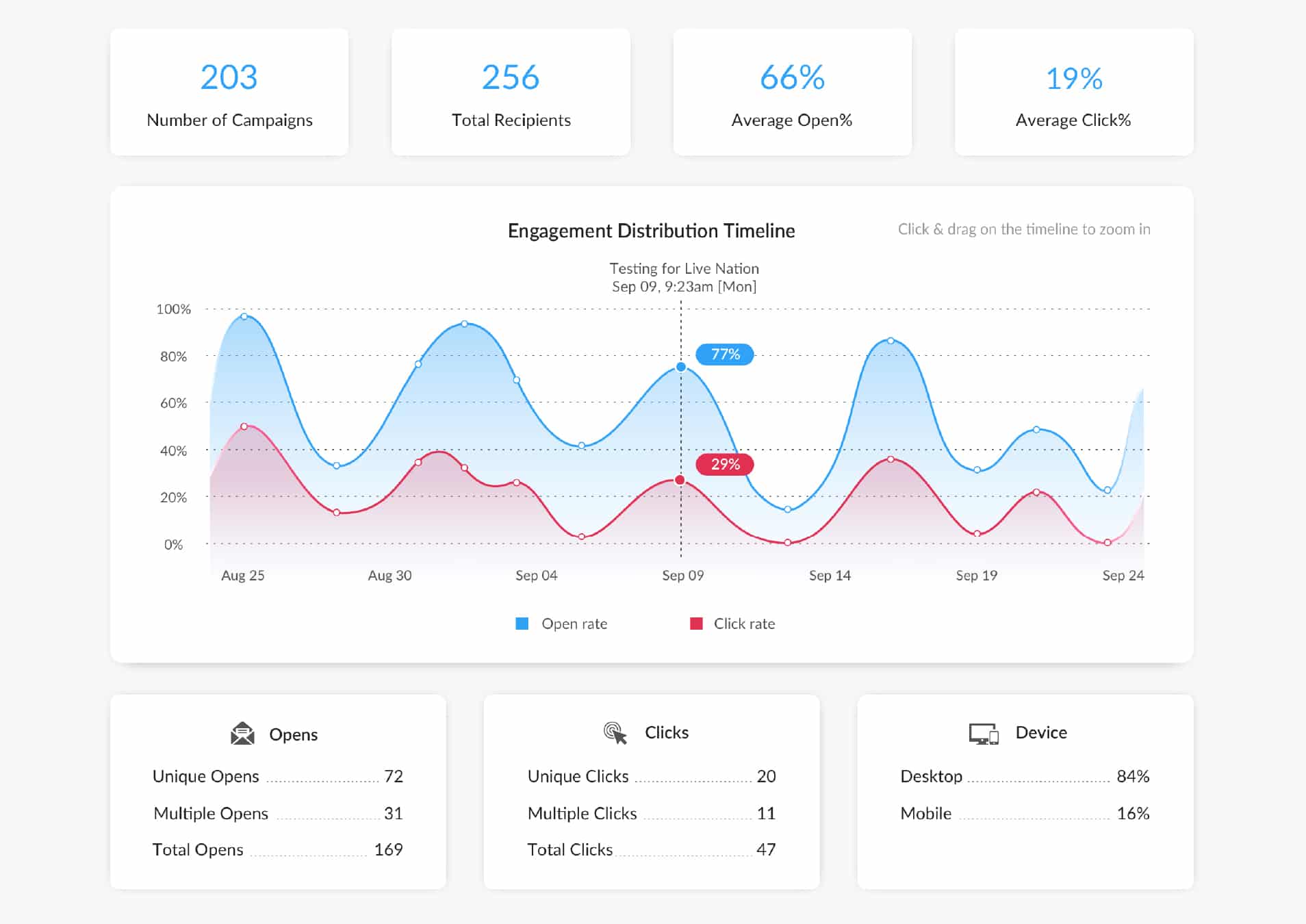
Not only does this show the success of past email campaigns, but you can use this data to shape your future internal communications. Find the optimal send time for your employees; sort results by different filters using segmented email stats; view your survey results; all from a centralized dashboard.
If your organization has internal or external regulations around email privacy, ContactMonkey’s anonymous email tracking allows you to gather individual email metrics while maintaining your employees’ privacy.
Want to know what kind of performance you should expect from your business? Check out ContactMonkey’s Benchmark Report to see how other companies in your sector perform.
8. Send event invitations via internal email
Whether your business has an in-person, remote, or hybrid workplace, employee events are a crucial way of sharing information and improving employee engagement. From town halls to company parties to employee appreciation days, you’d be surprised at how often you’re inviting your employees to events.
Using ContactMonkey’s event management features, you can host better events and engage your employees with ease using your existing company emails. Embed invitations into your internal emails, track employee RSVPs, and collect employee comments which can help you structure your events:
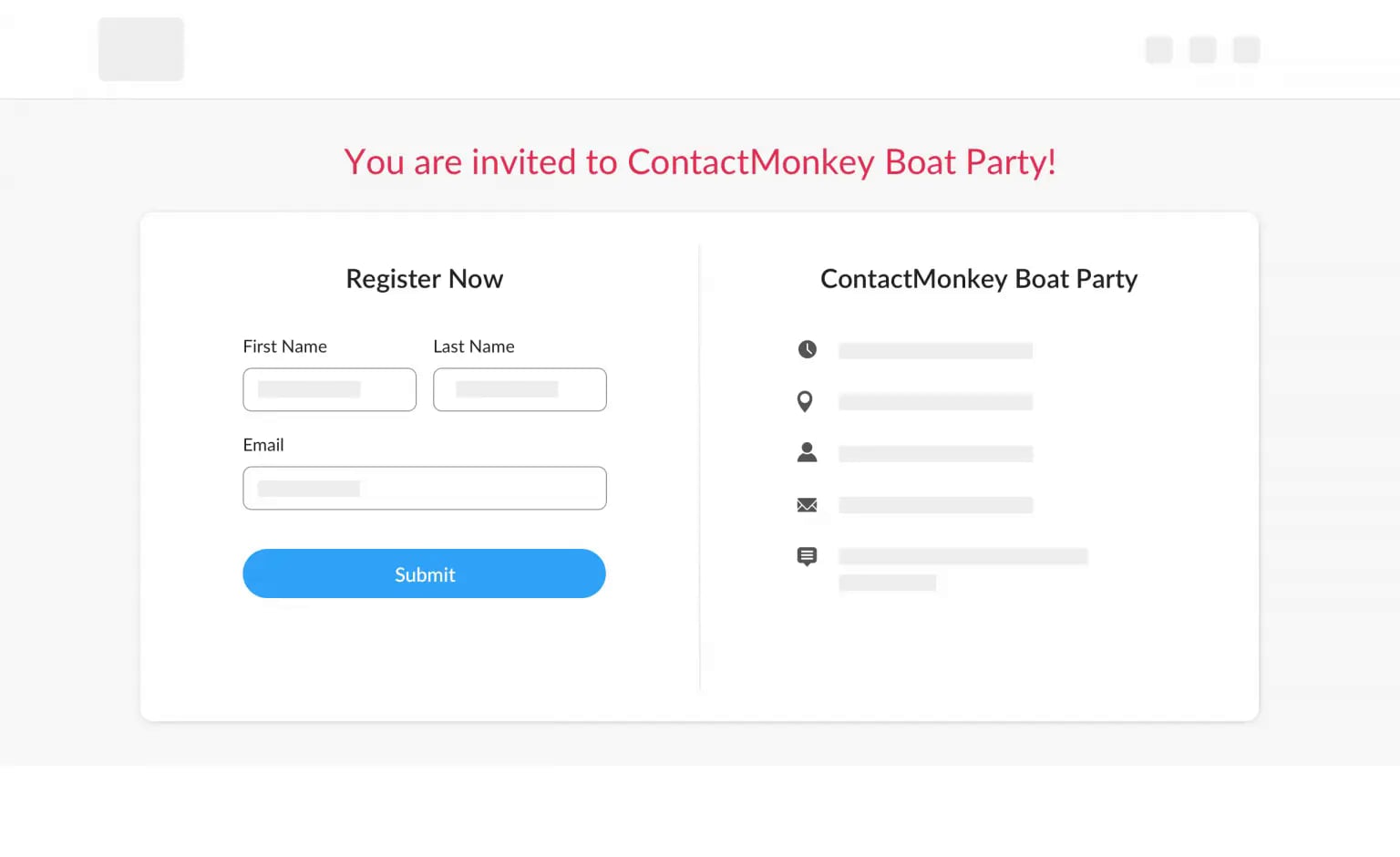
All of your RSVPs and employee comments are viewable from your anayltics dashboard. We suggest using scheduled email sending to maximize the open rate of your invitations to ensure good attendance for your events.
9. Save time with email templates
Consistent internal communications are crucial for high email engagement. But with consistency inevitably comes repetition. Save time on your recurring internal emails by using email templates. An email template takes all the design work out of creating beautiful internal communications; all you need to do is plug in your information!
ContactMonkey’s drag-and-drop email template builder makes it super easy to create your own email templates. It also includes numerous pre-made internal communication email templates to choose from. Here are just a few employee newsletter email templates included with ContactMonkey:
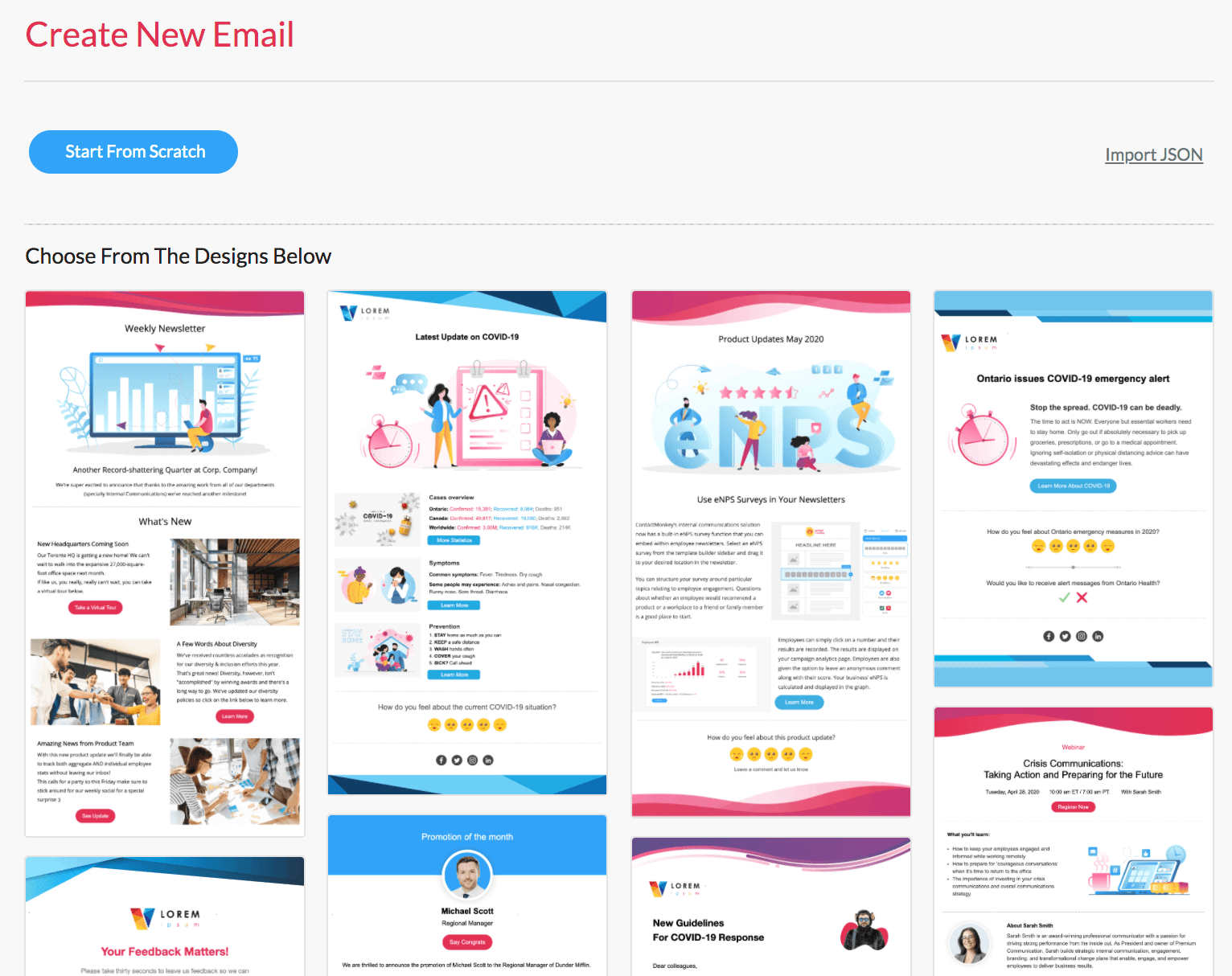
Choose from our constantly-updating selection of professionally-designed themes to grab your employees’ attention. Want a custom-made theme for your internal communications? We can build personalized themes for our customers!
10. Send at the optimal times
Timing is key when it comes to internal communications. You want to make sure that employees are receiving your messages at a time when they are most likely to engage with them. Consider factors such as time zones, work schedules, and other events or deadlines that may affect timing.
You can determine the best time to send emails by using internal email analytics. This data will help you determine when employees are most likely to open and click through your emails. For example, you may find that your remote team is most engaged with emails sent after lunch, while your in-office staff typically opens their emails first thing in the morning.
Scheduled email sending
The best time to send out engaging internal emails is going to vary between organizations and industries. As a result, you just need to look at where you work as a unique case. Be prepared to:
- Gather employee data
- Study the data and follow up where necessary
- Run employee focus groups to dive deeper into trends in your data
- Test out multiple options until you find a clear winner
With ContactMonkey’s internal communications tool, you can easily schedule your newsletters to send when your employees are most likely to engage with them:
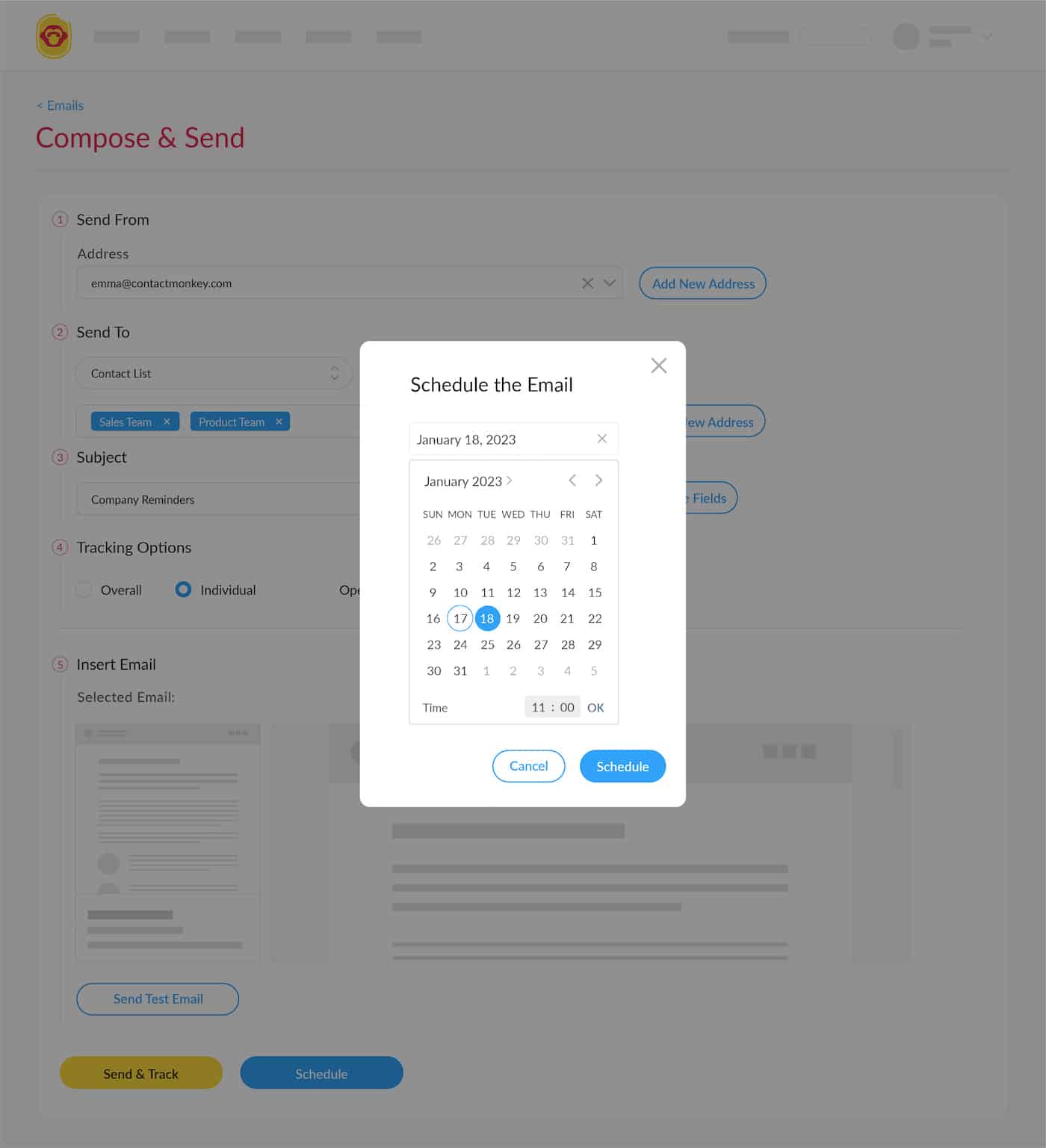
You can use an internal communications content calendar to plan your yearly, monthly, and weekly internal emails ahead of time. Planning your sends gives you more time to create them so you’re not scrambling last minute.
11. Regular communication
Consistency is also important when it comes to internal email best practices. Establish a regular cadence for your emails, such as a weekly or monthly newsletter, so that employees know what to expect and can plan accordingly.
Overcommunicating can lead to employees feeling overwhelmed, so try to keep your emails focused and relevant. Finding the right balance between meaningful content and frequency will be crucial to maintaining employee engagement.
12. Have fun creating engaging internal emails
If you want to create engaging internal emails, it’s worth thinking about what makes the organization—and its people—so special. Embrace the unique characteristics of the people you’ll be addressing with your internal newsletter, and present the information to them in a format that aligns with how they already consume content.
Remember, don’t be afraid to experiment, because you can always ask for feedback later. If you’re thinking about starting to send out an employee newsletter and have no clue where to start, keep some of these ideas in mind once you have your internal communications plan in place.
Making the Most of Your Internal Communications
Employee engagement strategies that work for one business may not work for the next. Trying different internal communication ideas and measuring their success is the best way to craft the most effective newsletter for your organization.
Check out our internal communications best practices for more tips on creating employee engagement with your emails.
ContactMonkey’s internal communications tool allows you to do both of those things and more:
- Change up the content and layout of your employee newsletter with the drag-and-drop template builder to find the right design for your organization
- Measure the success of your internal communications with email analytics within the campaign dashboard
- Gather employee feedback about your newsletter, or any topic
- Conduct Pulse and eNPS surveys with ease
If what you just read has you curious about using software for internal communications, we’d encourage you to grab a free trial of ContactMonkey’s internal email tracking tool for Outlook and Gmail. Let’s chat about what you’re hoping for in your personalized free demo!
